In a new scientific paper, researchers from King Abdullah University of Science and Technology (KAUST) in Saudi Arabia presented the 33.7% efficient perovskite-silicon tandem solar cell announced in May last year. They explained that the device is based on a perovskite additive known as tetrahydrotriazinium, which reportedly improves the phase stability of the perovskite film under heat and light conditions.
A team of researchers from King Abdullah University of Science and Technology (KAUST) has revealed the details of the 33.7% efficient perovskite-silicon tandem solar cell that the Saudi university announced in May 2023.
In the study “Enhanced cation interaction in perovskites for efficient tandem solar cells with silicon in Science”, published in Sciencethe scientists explained that they had developed the tandem solar cell using a new perovskite additive known as tetrahydrotriazinium, which was synthesized in situ in combination with methylenediammonium dichloride in a precursor solution.
“Our method involves the use of an additive strategy, which is a simple step, albeit with complex chemistry behind it, that significantly improves an already good cell platform to a better level,” Erkan Aydin, the corresponding author of the study, told me. pv magazine. “Additionally, our compositional tuning approach improves the phase stability of these films under heat and light conditions.”
The cell architecture was based on the tandem device that achieved a certified efficiency of 32.5% in 2023, which was achieved by “focusing on the efficient interconnection of perovskite and silicon subcells, together with extreme optical management,” according to Aydin.
Co-study author Stefaan De Wolf emphasized that the laboratory-scale findings require industry collaboration before incorporating tetrahydrotriazinium into the commercial production of perovskite-silicon tandem cells. “Our laboratory efforts to reduce performance degradation at a lower cost are scientific. These iterative improvements could have major industrial implications, but we need partners to show how we can move our findings to a larger scale,” he said.
“The industry response has been positive and we are looking for industry partners to collaborate on these aspects on scaled device platforms,” Aydan added.
The 33.7% efficient cell, which was certified by the European Solar Test Installation (ESTI), had a device area of 1 cm2 and a top perovskite cell based on a pin design. It also achieved an open circuit voltage of 1.985 V, a short circuit density of 21.02 mA cm2 and a fill factor of 81.6%.
In comparison, a reference device without tetrahydrotriazinium treatment achieved an energy conversion efficiency of 32.8%, an open circuit voltage of 1.949 V, a short circuit density of 20.96 mA cm2 and a fill factor of 80.5%.
The treated device also showed improved stability after 1500 hours compared to cells prepared without tetrahydrotriazinium. Furthermore, the researchers found that the unencapsulated perovskite-silicon tandem device retained more than 82% of its initial performance after 300 minutes of maximum power point (MPP) tracking under continuous illumination of 1 sun, in ambient air at 75 C, while the control device was within 120 minutes reached 80% of its original performance.
Looking ahead, says Esma Unger, co-corresponding author at KAUST pv magazine that the long-term research goal of the KAUST KPV-LAB is to develop a realistic, high-efficiency photovoltaic solution for sunny and warm climates. “At KAUST, we focus not only on creating highly efficient tandem solar cells, but also on ensuring their long-term operational stability,” he stated, adding that stability and addressing the remaining challenges is now the main focus .
The work was described by researchers from KAUST and Marmara University in Turkey.
This content is copyrighted and may not be reused. If you would like to collaborate with us and reuse some of our content, please contact: editors@pv-magazine.com.


